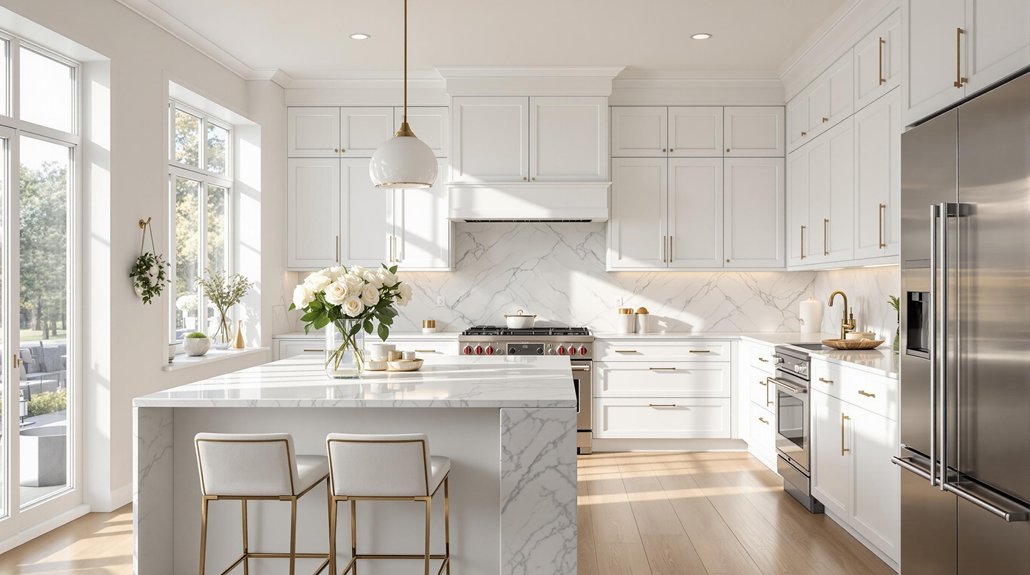
18 White Kitchen Ideas That Feel Airy, Modern, and Elegant
Eighteen white kitchen ideas leverage spatial clarity and tonal cohesion to create airy, modern elegance. High-contrast drama with bold cabinet colors, minimalist neutrals, glamorous accents in brass, and mixing of materials enhance both visual depth and function. Honoring original details, introducing artistic elements, and layering textured finishes contribute architectural authenticity and warmth. Strategic lighting, multifunctional storage, and curated color pairings boost utility and aesthetic appeal. Further exploration reveals how these concepts sharpen design impact and adaptability.
Key Takeaways
- Incorporate high-gloss cabinetry and reflective surfaces to enhance light and create a spacious, airy atmosphere.
- Pair white cabinets with bold contrasting elements like black or navy blue islands for modern elegance and visual depth.
- Integrate natural wood accents or reclaimed beams to add warmth and textural interest without compromising brightness.
- Use statement lighting, such as brass fixtures or artistic pendant lights, to infuse glamour and architectural sophistication.
- Maximize storage and openness with floor-to-ceiling cabinetry, open shelving, and under-cabinet lighting for a streamlined, functional feel.
Cozy Cottage Charm
While maintaining a commitment to brightness and spatial efficiency, cozy cottage kitchens leverage white cabinetry to amplify natural light and create an open, airy environment. This approach maximizes the perception of available space, especially when paired with reflective surfaces and soft color palettes.
White elements, including cabinetry and trim, serve as a neutral foundation, allowing for the integration of hand-painted backsplash tiles that introduce artisanal character. Accents such as a Silvery Blue ceiling and rustic wood textures further enhance visual depth while reinforcing the cozy cottage aesthetic.
Incorporating reclaimed wood in cabinetry and flooring adds unique grain patterns and weathered textures, which complement the cozy cottage charm with a touch of rustic authenticity.
These spatial strategies establish warmth and approachability, transforming the kitchen into an inviting hub for communal activities. Ultimately, the interplay of white cabinetry with historic and rustic features results in a timeless appeal, aligning with current trends favoring elegant, lived-in environments.
High Contrast Drama
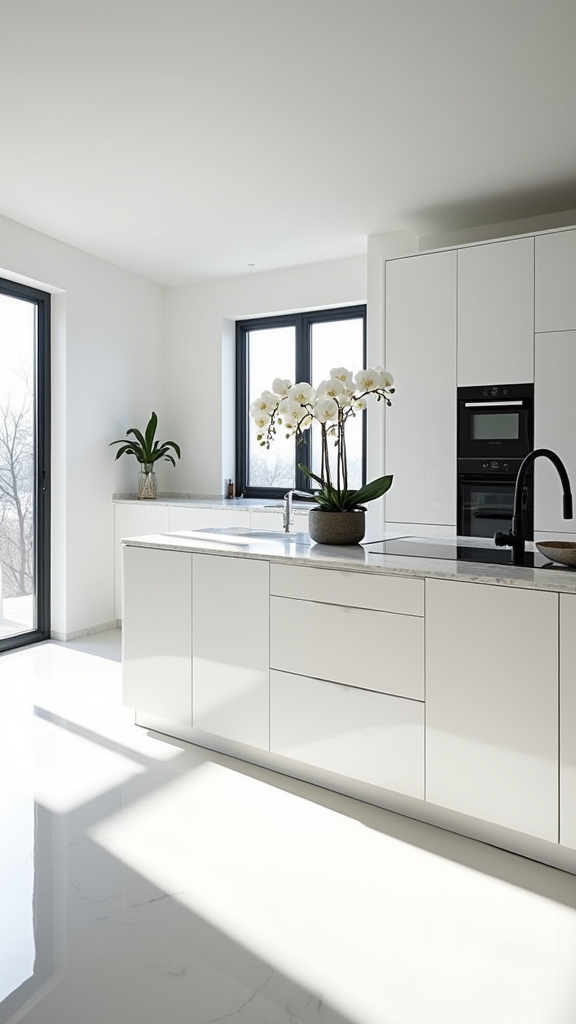
A Carrara marble island anchors the high contrast kitchen, establishing a visual centerpiece amid sleek black cabinetry and crisp white accents. This spatial composition utilizes the inherent drama of high contrast kitchens to generate visual interest and depth. Bright white accents amplify natural light, optimizing the room’s perceived volume and ensuring a luminous, inviting atmosphere. The modern design approach merges bold aesthetics with practical surfaces, as marble’s smooth texture eases maintenance for active culinary spaces. Homeowners favor this trend for its dynamic interplay of color and material, making a striking statement while retaining functionality. Greige cabinets can seamlessly blend with various design styles, adding timeless appeal to the kitchen space. The following table illustrates key elements of this design strategy:
| Element | Functionality | Visual Impact |
|---|---|---|
| Carrara Marble | Easy to clean, durable | Elegant centerpiece |
| Black Cabinetry | Storage, structure | Bold contrast |
| Bright White Accents | Light reflection, spaciousness | Airy, modern feel |
Minimalist Neutrals
Following the bold interplay of dark and light, minimalist neutrals redefine spatial calm through a restrained palette of soft whites, beiges, and greys. In contemporary design, these hues foster serenity and openness, ensuring white kitchens can feel expansive and uncluttered. Natural light amplifies the effect, highlighting subtle nuances in matte finishes and refined textures. Precision in spatial planning and the selection of high-quality materials underpin the minimalist ethos, maximizing function and elegance without excess. Matte cabinetry: Soft, low-sheen finishes enhance warmth, resisting the sterility often associated with all-white spaces. Open shelving: Strategic placement allows curated kitchenware to become part of the overall aesthetic, lending functionality and visual interest. Natural wood accents: Integrating light wood or foliage injects organic texture, balancing the neutral scheme. Premium surfaces: Surfaces like Venetian plaster and subdued stone boost the kitchen’s tactile sophistication. Light greige cabinets reflect natural light, optimizing space in smaller kitchens while fostering warmth and sophistication.
Glamorous Accents
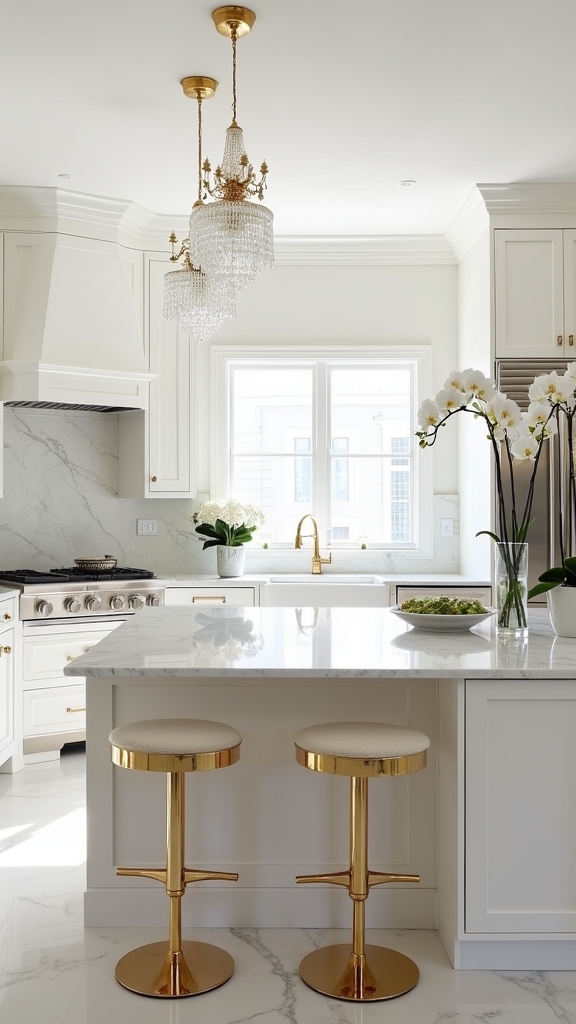
Elevating a white kitchen’s visual hierarchy, glamorous accents rely on strategic use of high-contrast materials and refined finishes to shift the spatial narrative toward sophistication.
Contrasting black elements against white cabinetry introduces a dramatic interplay of light and shadow, establishing depth and visual intrigue. Brass handles and elegant fixtures infuse warmth and a tactile sense of luxury, enhancing the kitchen’s overall ambiance.
Integrating marble or quartz countertops or backsplashes provides an opulent, yet cohesive surface that echoes the purity of the white palette while adding subtle veining for complexity.
Layering glossy and matte finishes across cabinetry and surfaces further enriches texture, while statement pendant lighting—whether industrial or vintage-inspired—serves as a functional sculptural element, reinforcing the contemporary glamour inherent in the design scheme.
White cabinets paired with gold hardware create a timeless aesthetic, marrying beauty with elegance.
Honoring Original Details
Honoring original details in a white kitchen emphasizes the preservation of historic fixtures, such as antique windows repurposed as cabinet fronts, to establish architectural authenticity.
Designers increasingly favor the strategic integration of classic elements—like period chairs or botanical prints—within modern layouts to achieve visual continuity.
This trend leverages custom cabinetry and premium finishes to create a harmonious blend of traditional character and contemporary performance.
Preserving Historic Fixtures
While contemporary white kitchens often prioritize minimalism, the deliberate preservation of historic fixtures—such as original windows, vintage light fittings, and ornate crown moldings—anchors the design in its architectural context.
This approach leverages the spatial narrative of the kitchen, where preserving original details becomes both an aesthetic and functional strategy. Integrating antique windows allows natural light to permeate, amplifying the kitchen’s airy quality without sacrificing authenticity.
Vintage light fixtures introduce sculptural interest and period-appropriate illumination, while reclaimed materials contribute texture and historical resonance.
To further emphasize these qualities, consider:
- Retrofitting antique windows for energy efficiency.
- Rewiring vintage light fixtures to meet modern codes.
- Showcasing reclaimed beams or cabinetry as focal points.
- Selecting hardware that references the kitchen’s original era.
This methodology fosters a timeless yet trend-forward ambiance.
Blending Classic and Modern
Building upon the architectural narrative established by preserved historic fixtures, the integration of classic and modern elements in white kitchens demands a strategic interplay of form and material.
Classic white cabinetry with shaker style doors serves as a timeless foundation, while the application of sleek, contemporary hardware introduces a modern feel. Visual interest is heightened through the juxtaposition of vintage or reclaimed materials—such as distressed wood accents or antique furniture pieces—against glossy finishes and stainless steel appliances.
High-contrast features, like a bold black vent hood or dark countertops, punctuate the space and prevent monotony. Employing a cohesive palette of classic whites and muted earth tones enhances spatial warmth without sacrificing elegance.
This trend-focused blend honors original details while embracing current design innovations.
Mediterranean Influences
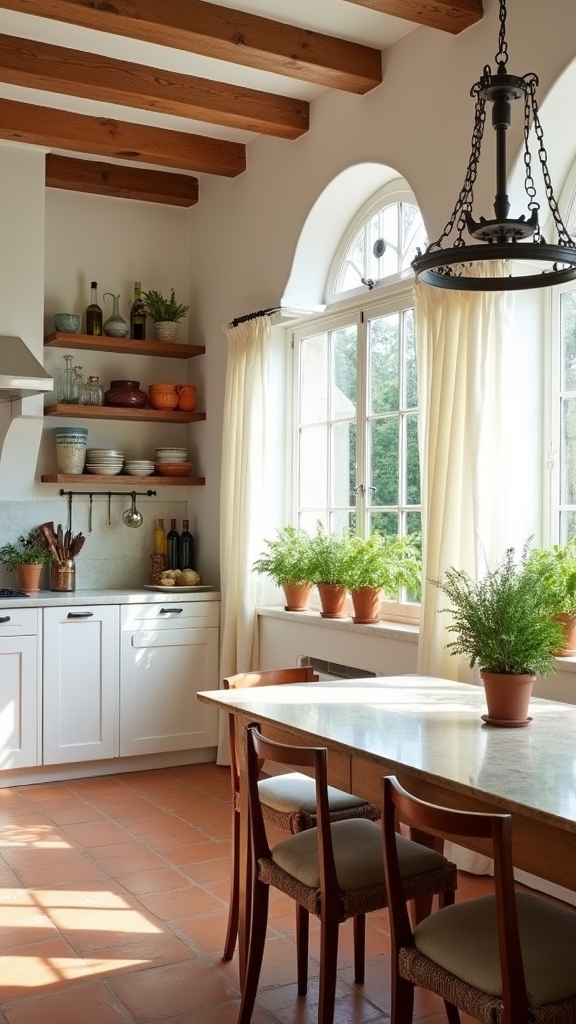
Evoking the sunlit elegance of coastal regions, Mediterranean-influenced white kitchens integrate crisp white cabinetry and wall tiles to maximize light diffusion and spatial openness.
This design ethos prioritizes a seamless interplay of brightness and texture, channeling both tradition and modernity. Spatial layering is achieved through the thoughtful juxtaposition of natural materials and architectural accents.
To further refine the Mediterranean aesthetic, designers frequently deploy elements that provide tactile and visual contrast.
Designers skillfully introduce contrasting elements, enriching Mediterranean white kitchens with dynamic interplay between texture and visual intrigue.
- White cabinetry: Maintains a luminous core, emphasizing clarity and openness.
- Rustic flooring: Incorporates terracotta or reclaimed wood, lending warmth and grounding the space.
- Natural materials: Adds authenticity through stone, ceramic, or wooden accents, enhancing environmental connection.
- Bold wall trim: Delivers visual punctuation, creating distinction against expansive white surfaces and reinforcing architectural rhythm.
Timeless Classic Appeal

Timeless classic appeal in white kitchens is anchored by enduring style elements such as Shaker cabinetry and vintage fittings, which maintain relevance across shifting design environments.
The persistent trend of white as a dominant color choice underscores its adaptability and market longevity. This spatial neutrality enables effortless integration with evolving accents and decor, ensuring sustained aesthetic and functional value.
Enduring Style Elements
While design trends continually evolve, white kitchens retain a pervasive presence due to their spatial versatility and ability to amplify natural and artificial light.
The enduring style elements of a modern kitchen often rely on a cohesive white colour scheme, which enhances the timeless quality of the space. White cabinets form the backbone of this aesthetic, providing a neutral foundation that complements both traditional and contemporary design.
Classic materials and structural choices are frequently utilized to guarantee longevity and adaptability.
- Integration of Shaker-style white cabinets for a refined, minimalist profile.
- Use of marble countertops, which introduce both durability and tactile luxury.
- Contrasting hardware and fixtures to provide visual depth without overwhelming the white palette.
- Layered lighting solutions to emphasize the reflective properties of the white colour scheme and maximize spatial perception.
Lasting White Color Trends
Despite the cyclical nature of interior design trends, the dominance of white in kitchen color palettes persists due to its unparalleled capacity to optimize spatial perception and adapt to evolving tastes.
Lasting white color trends remain integral to white kitchen design, as the shade’s inherent versatility guarantees compatibility across a spectrum of aesthetics, from modern look minimalism to traditional charm.
Bright whites with subtle blue undertones deliver a crisp environment, enhancing perceived volume and cleanliness, while warmer, muted whites introduce an inviting ambiance.
Current market analysis reveals a notable evolution: homeowners increasingly juxtapose white cabinetry and surfaces with earthy tones or pastel accents, introducing visual dynamism without compromising the classic foundation.
This adaptive approach underscores white’s ongoing relevance as a resilient, trend-forward design solution.
Smart Solutions for Small Spaces
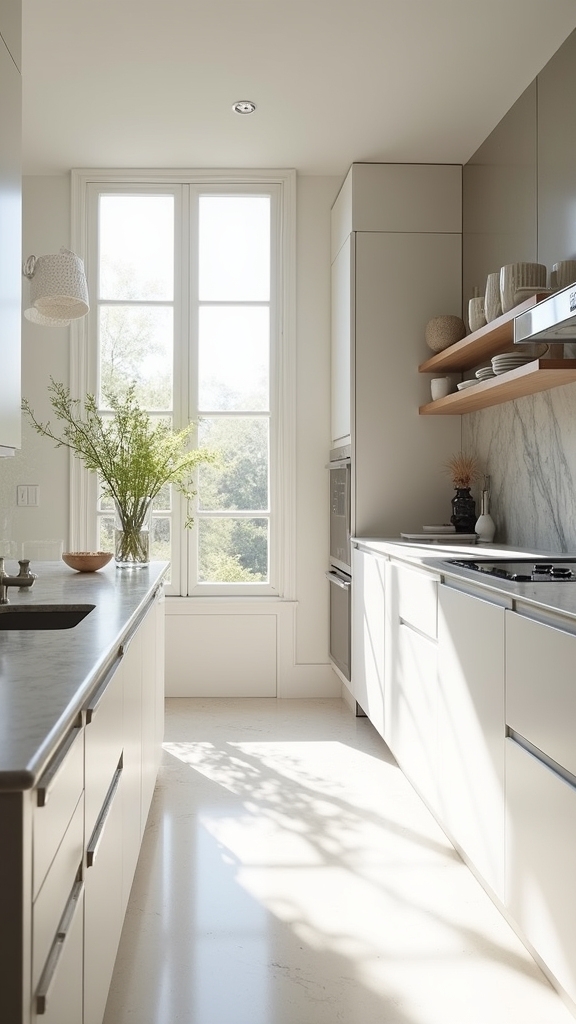
Maximizing efficiency in compact kitchens requires a strategic approach to spatial organization and design. The application of a white color scheme in a small kitchen is pivotal for reflecting light and amplifying perceived space.
Integrating advanced kitchen storage solutions alongside trend-forward design elements enhances both functionality and aesthetics. The following smart solutions address key concerns in small kitchen optimization:
- Utilize floor-to-ceiling cabinetry to capitalize on vertical real estate, increasing storage capacity while visually elongating the space.
- Replace upper cabinets with open shelving to maintain accessibility and promote an airy, uncluttered environment.
- Select multifunctional furniture, such as islands with built-in storage, to consolidate functions and minimize visual bulk.
- Install under-cabinet LED lighting to illuminate work zones and accentuate the overall openness of the kitchen.
- Consider multi-functional appliances to save space and maintain efficiency in a small kitchen, as they provide multiple uses without occupying additional counter space.
Trend-Forward Brightness
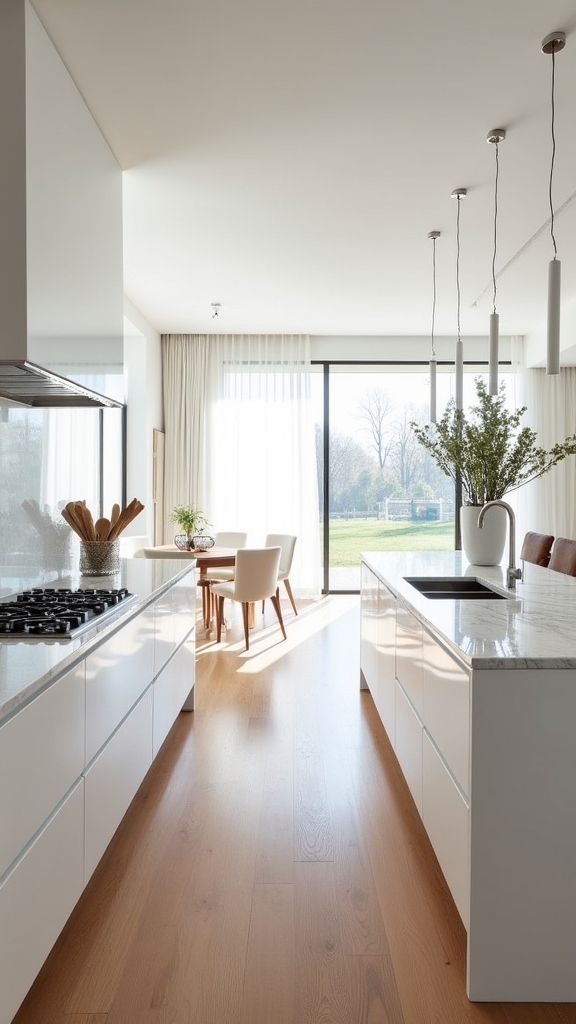
Contemporary kitchen design leverages the reflective qualities of white finishes to optimize both natural and artificial illumination, enhancing spatial perception throughout the room.
Strategic placement of windows and the application of high-gloss surfaces intensify brightness, supporting a visually expansive and modern environment.
This trend-forward approach guarantees that even compact layouts achieve a luminous, airy aesthetic.
Maximizing Natural Light
A white kitchen achieves ideal spatial expansion and luminosity through strategic harnessing of natural light. Maximizing natural light not only accentuates the intrinsic brightness of white cabinetry and surfaces but also enhances the perception of openness, especially in compact floor plans.
In contemporary design, the interplay between natural illumination and reflective surfaces fosters an airy atmosphere that is both welcoming and visually dynamic. Architectural planning and material selection are essential to optimizing daylight exposure, creating a seamless integration of indoor and outdoor environments.
- Install expansive windows or skylights to increase daylight penetration and reduce artificial lighting needs.
- Select sheer or minimal window treatments to optimize light flow while maintaining privacy.
- Utilize reflective surfaces such as glossy tiles or quartz countertops for amplified brightness.
- Maintain an open layout to facilitate unobstructed light distribution throughout the kitchen.
Illuminating With White Finishes
While natural light forms the foundation of a luminous kitchen environment, the implementation of white finishes advances spatial brightness to a trend-forward level.
Bright white cabinetry, when paired with light-colored countertops, strategically amplifies reflected light, optimizing the perceived volume of even compact layouts. The integration of gloss finishes on select white elements, such as backsplashes or cabinet fronts, further intensifies the modern aesthetic by enhancing surface reflectivity and visual clarity.
For additional visual interest, juxtaposing matte and glossy white textures introduces depth while sustaining cohesion within the bright color palette. Incorporating open shelving and streamlined white light fixtures in key zones creates layered illumination, reinforcing a contemporary elegance.
Ultimately, the precise deployment of white finishes transforms the kitchen into an expansive, inviting, and on-trend spatial experience.
Playful Pops of Color
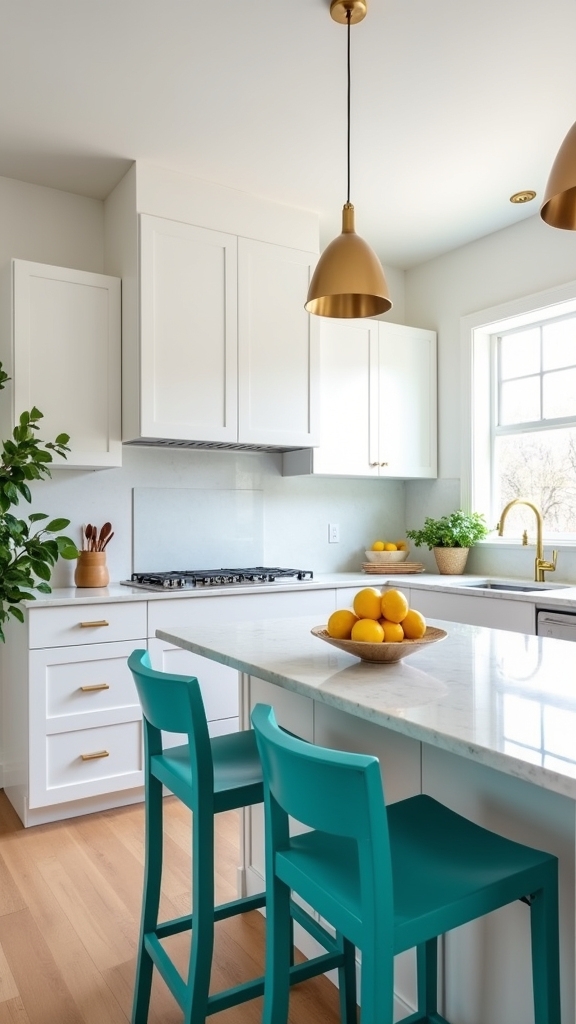
How can a white kitchen remain visually compelling yet minimalist? The integration of playful pops of color within a primarily white palette introduces a dynamic, trend-forward aesthetic while retaining spatial clarity.
Playful pops of color enliven a minimalist white kitchen, adding dynamic visual interest while preserving a sense of clarity and calm.
Strategic placement of vibrant accessories and carefully selected color accents can transform the kitchen into an inviting, modern space. Consider these approaches for enhanced impact:
- Incorporate vibrant accessories—such as colorful dishware, art, or textiles—to infuse energy without disrupting the minimalist framework.
- Apply colorful backsplash tiles or patterned flooring to create visual rhythm, anchoring the kitchen’s central zones.
- Utilize colorful light fixtures or hardware for subtle yet effective bursts of personality and contemporary flair.
- Integrate vivid plant life or fresh fruits for a natural, playful touch that maintains an airy, elegant ambiance.
Incorporating decorative tiles for backsplashes can add visual interest and character, complementing the playful yet sophisticated aesthetic.
These techniques optimize both form and function.
Bold Color Pairings
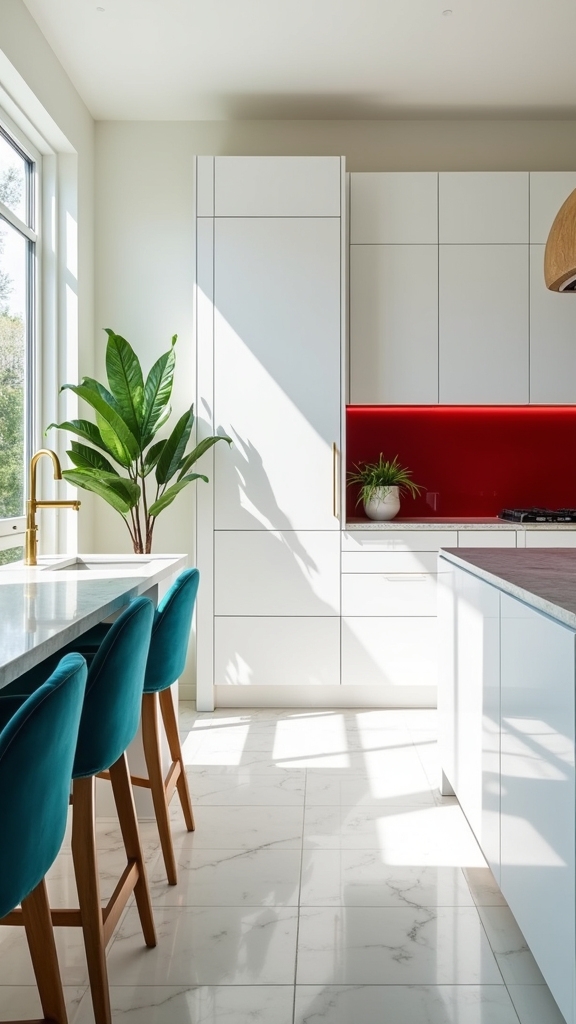
When executed with precision, bold color pairings in a white kitchen introduce visual tension and spatial hierarchy, amplifying both modernity and perceived scale.
Strategic integration of navy blue or deep forest green cabinetry generates striking contrast, accentuating architectural lines while preserving the kitchen’s inherent airiness.
Vibrant accents—such as a saturated red island or a sunny yellow backsplash—act as dynamic focal points, injecting energy and contemporary flair.
Rich jewel tones paired with white surfaces deliver depth and sophistication, cultivating a luxe ambiance without visual overcrowding.
High-contrast combinations, especially white juxtaposed with charcoal gray or black, delineate zones within the layout, reinforcing spaciousness and elegance.
The fusion of black and gold creates sophistication and opulence, making a bold statement in kitchen design.
Introducing bold hues through accessories or statement pieces enables adaptability, maintaining a fresh, trend-forward aesthetic amid evolving design preferences.
Natural Wood Warmth
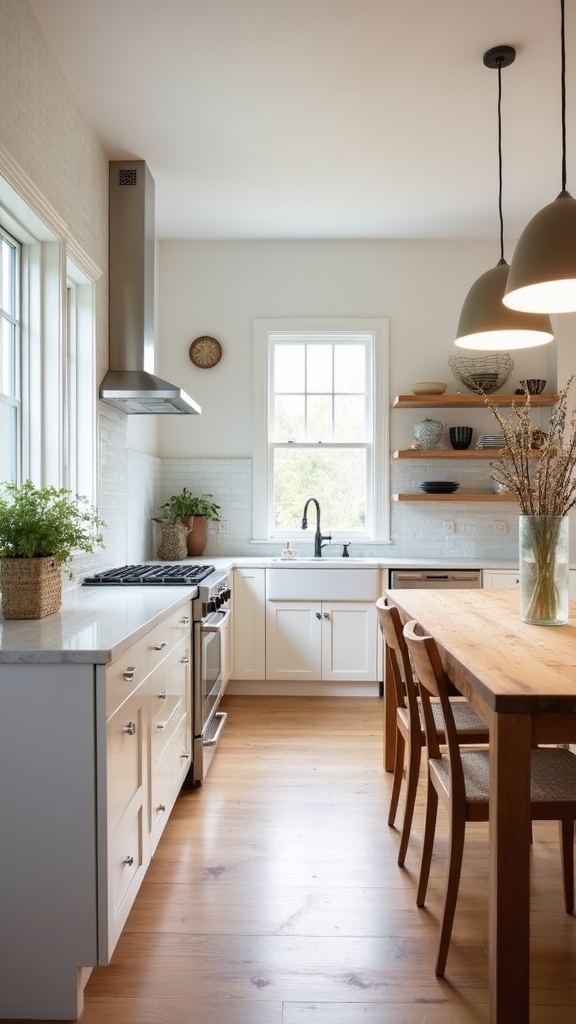
Introducing timber accents into a white kitchen establishes a nuanced interplay of texture and tone, softening the overall visual impact. The strategic integration of wood—whether in beams, shelving, or worktops—bridges the gap between crisp modernity and organic warmth. This trend-driven approach not only enhances tactile variety but also optimizes the spatial balance between lightness and depth. Incorporating wood panel kitchen island designs can add both warmth and texture, creating a more inviting and visually interesting kitchen space.
Timber Accents for Texture
Timber accents introduce essential texture and visual contrast within white kitchen environments, aligning with current trends favoring natural finishes.
In contemporary kitchen design, the integration of timber elements—such as reclaimed beams or bespoke cabinetry—counterbalances the sleekness of an all-white kitchen, infusing warmth and layered visual interest.
The interplay between crisp surfaces and organic wood grains creates spatial depth while mitigating sterility. Light wood species like oak and maple preserve the kitchen’s sense of airiness, enhancing luminosity without overpowering the palette.
- Reclaimed timber beams: Add architectural definition and rustic charm, grounding expansive ceiling planes.
- Wooden countertops: Offer tactile variation, softening the shift between cabinetry and workspace.
- Timber-framed open shelving: Increases display opportunities while breaking up uniform white expanses.
- Integrated wood handles or trim: Introduce subtle continuity, reinforcing the kitchen’s cohesive warmth.
Blending Wood and White
Although white kitchens remain a staple in contemporary interiors, the strategic integration of natural wood elements has emerged as a defining trend to mitigate visual sterility and enhance spatial warmth. Blending wood and white introduces a warm contrast that boosts the spatial dynamic, providing an inviting counterbalance to the crispness of white finishes. Light wood tones—such as oak or maple—layer visual interest while maintaining an airy ambiance, especially effective in compact layouts. Reclaimed wood accents or flooring ground the design, fostering a connection to organic textures. Thoughtful deployment of elements like open shelving or butcher block countertops further diversifies the tactile palette. The table below illustrates key methods:
| Method | Resulting Effect |
|---|---|
| Exposed ceiling beams | Visual warmth, structure |
| Light wood cabinetry | Contemporary coziness |
| Reclaimed wood flooring | Depth, natural grounding |
| Wooden open shelving | Textural variety, balance |
Open Shelving Displays
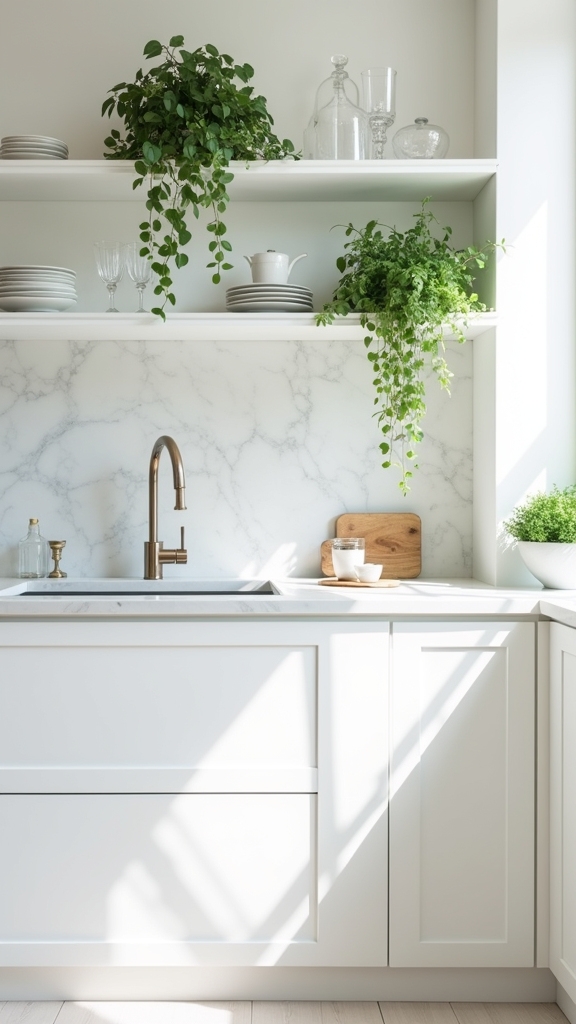
Open shelving displays in white kitchens optimize spatial efficiency by enhancing accessibility and creating an uninterrupted visual flow. This design strategy leverages a minimalist approach, eliminating the bulk of traditional cabinetry to maintain a serene, organized environment.
Open shelving, when painted to match white walls, amplifies the airy ambience and visually expands narrow spaces. Curated collections placed on these shelves introduce visual interest without disrupting cohesion.
Matching open shelving with white walls brightens kitchens and makes even compact spaces feel more expansive and visually unified.
- Open shelving increases accessibility by keeping daily-use items like plates and cookware within easy reach, supporting efficient workflow.
- A minimalist approach with limited display items prevents clutter, preserving the clean, modern aesthetic of white kitchens.
- Matching shelf and wall colors strengthens spatial unity, making compact kitchens appear more expansive.
- Selective display of decorative or functional items provides opportunities to personalize the space while retaining elegance.
Incorporating wall-mounted docking shelves can further enhance organization by providing dedicated spaces for charging devices, keeping countertops free from clutter and maintaining a sleek kitchen ambiance.
Inviting Seating Arrangements
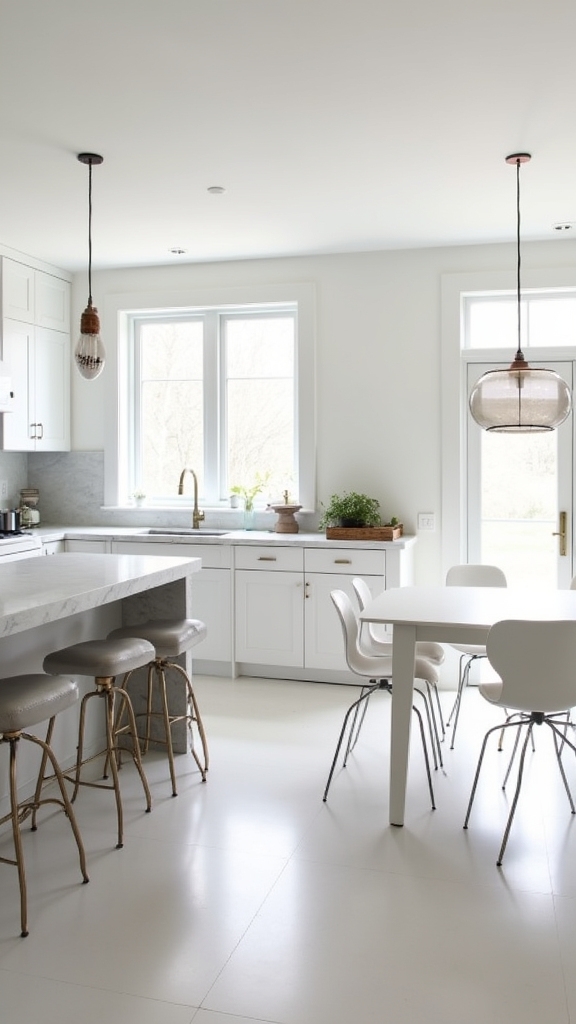
Optimizing seating arrangements in a white kitchen involves strategic selection of elements such as cozy breakfast nooks, contemporary bar stools, and integrated banquette solutions.
Attention to spatial flow and the use of lightweight, visually cohesive furnishings support current trends in open-plan, multifunctional interiors.
Thoughtful placement and material choices guarantee both ergonomic comfort and aesthetic harmony within the overall kitchen design.
Cozy Breakfast Nook Ideas
Spatial planning within a white kitchen frequently incorporates a dedicated breakfast nook, emphasizing both function and comfort through built-in benches or cushioned seating layered with soft textiles.
This configuration produces a cozy enclave, optimizing unused corners and maximizing floor efficiency.
White kitchens benefit from nooks featuring light-colored, natural wood tables, which reinforce the room’s airy aesthetic and contemporary appeal.
Strategic lighting—such as pendant fixtures or wall sconces—infuses warmth and intimacy, essential for an inviting morning atmosphere.
Positioning the breakfast nook near windows leverages natural daylight, enhancing spatial openness and visual flow.
- Built-in benches with plush cushions deliver ergonomic support and cozy ambiance.
- Natural wood tables contrast elegantly with the white kitchen palette.
- Layered textiles—pillows and throws—personalize the breakfast nook environment.
- Intentional lighting design raises mood and functional brightness.
Stylish Bar Stool Choices
How does one achieve both ergonomic function and visual cohesion within a white kitchen’s seating area? The selection of bar stools plays a critical role in defining both spatial dynamics and the modern aesthetic of the environment.
Opting for stools with sleek, minimalist profiles supports the airy visual quality while emphasizing clean architectural lines. Materials such as matte-finished metal, light-toned wood, or clear acrylic introduce a deliberate contrast against white cabinetry, layering depth without visual clutter.
Adjustable heights allow for adaptability across varied counter elevations, maximizing user comfort. For increased hospitality, comfortable cushions or soft upholstery in neutral or muted tones guarantee that seating remains inviting.
Ultimately, curated bar stools foster a seamless integration of ergonomic design and contemporary elegance, reinforcing the kitchen’s cohesive identity.
Banquette Seating Solutions
Banquette seating introduces a tailored solution for white kitchens, merging spatial efficiency with contemporary design sensibilities.
These banquette seating solutions transform underutilized corners into purposeful, inviting zones, reinforcing the kitchen’s role as a social nucleus.
In modern kitchen layouts, built-in banquettes optimize floor space while maintaining a streamlined aesthetic.
The interplay of soft, neutral cushions and elegant textiles amplifies comfort, cultivating a cozy atmosphere without compromising the airy integrity of a white kitchen.
Material selection—whether sleek wood or refined upholstery—adds tactile variation and visual depth, ensuring the banquette becomes a focal point.
- Maximizes space efficiency in compact white kitchen footprints.
- Enhances multifunctionality for dining, working, or entertaining.
- Incorporates soft, neutral textiles for heightened comfort and warmth.
- Introduces texture and sophistication with curated material choices.
Mixing Materials and Textures
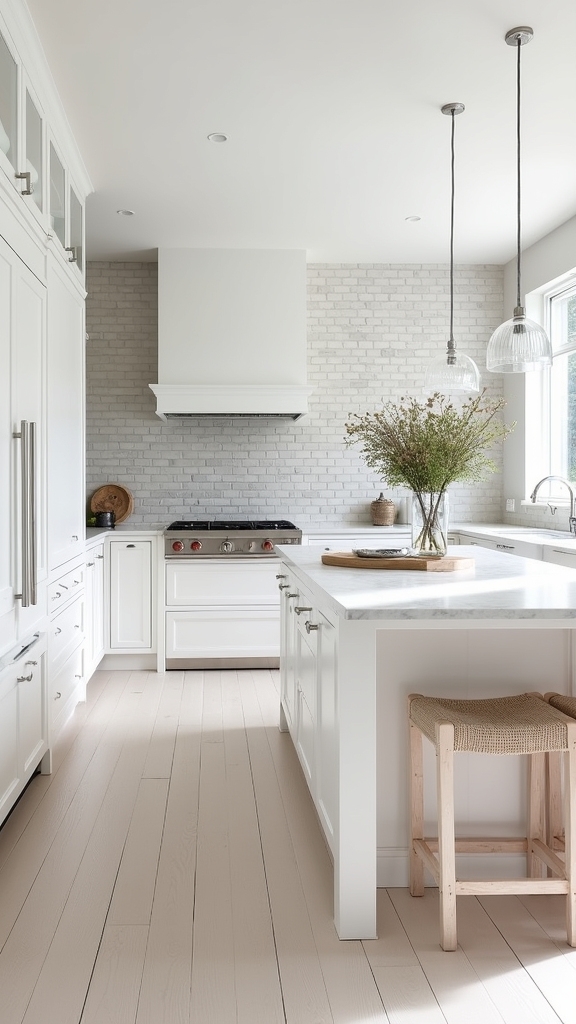
When designing a white kitchen, integrating a strategic mix of materials and textures establishes both visual hierarchy and tactile interest within the space. Current trends emphasize mixing materials such as high-gloss cabinetry with organic elements like ribbed wood or textured stone, generating visual contrast while maintaining a cohesive palette. Texture variety—achieved by pairing smooth quartzite countertops with rough-hewn wood details or woven textiles—prevents monotony and introduces spatial depth. Metallic accents, including brushed brass fixtures or chrome hardware, punctuate white surfaces with reflective warmth, aligning with contemporary design sensibilities. Incorporating reflective surfaces like stainless steel or glossed countertops amplifies light, creating a sense of spaciousness and airiness in the kitchen. The interplay of diverse finishes not only enhances the aesthetic dimension but also supports functional zoning, as different surfaces are optimized for specific culinary or social uses. This layered approach yields a modern yet inviting kitchen environment.
Retro-Inspired Touches
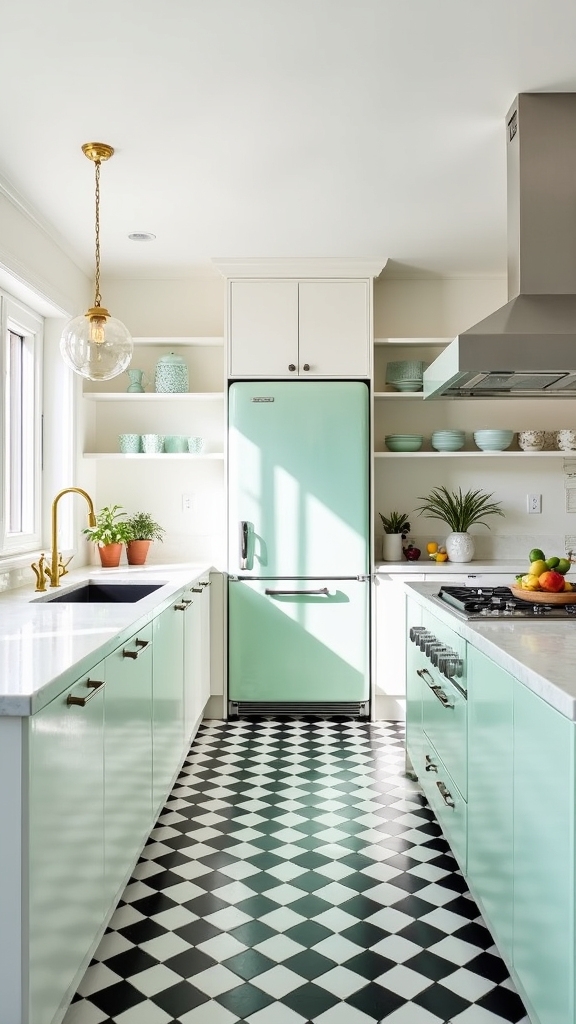
While contemporary white kitchens often favor streamlined minimalism, integrating retro-inspired touches introduces layers of historical reference and visual complexity.
Strategic placement of vintage appliances, such as a 1930s O’Keefe & Merritt stove, can become a focal point, infusing nostalgia without compromising modern efficiency.
A vintage appliance, thoughtfully positioned, serves as both a nostalgic centerpiece and a testament to enduring functionality in the modern kitchen.
A patterned backsplash, featuring mid-century motifs, delivers dynamic contrast and spatial rhythm within the monochromatic environment.
Retro-style light fixtures—globe pendants or industrial sconces—provide both functional illumination and stylistic coherence, reinforcing the kitchen’s period aesthetic.
Colorful barstools and ceramic dishware punctuate the space with vibrant energy, creating a playful counterpoint to the dominant white palette.
- Vintage appliances as functional décor
- Patterned backsplash for visual interest
- Retro light fixtures to reinforce theme
- Colorful barstools for spatial accentuation
Artistic Additions

Building upon retro-inspired accents, artistic additions offer another dimension of spatial intrigue within white kitchen design. Infusing visual interest through carefully selected artwork—such as vibrant paintings or sculptural pieces—transforms a neutral environment into an expressive, inviting space. Colorful glass pendant lights not only punctuate the palette but also enhance both ambient light and architectural cohesion. A statement backsplash, utilizing artistic tiles or custom patterns, disrupts visual monotony and introduces depth to otherwise uniform cabinetry. Open shelving enables the display of curated culinary collections, blending functionality with aesthetic appeal for a gallery-like effect. Integrating organic elements, such as potted plants or fresh herbs, further animates the space.
| Artistic Element | Spatial Effect |
|---|---|
| Vibrant Artwork | Focal Point, Personality |
| Colorful Pendant Lights | Light, Accent, Cohesion |
| Statement Backsplash | Depth, Texture, Visual Interest |
| Curated Open Shelving | Functionality, Display, Style |
Elevating With Subtle Pastels
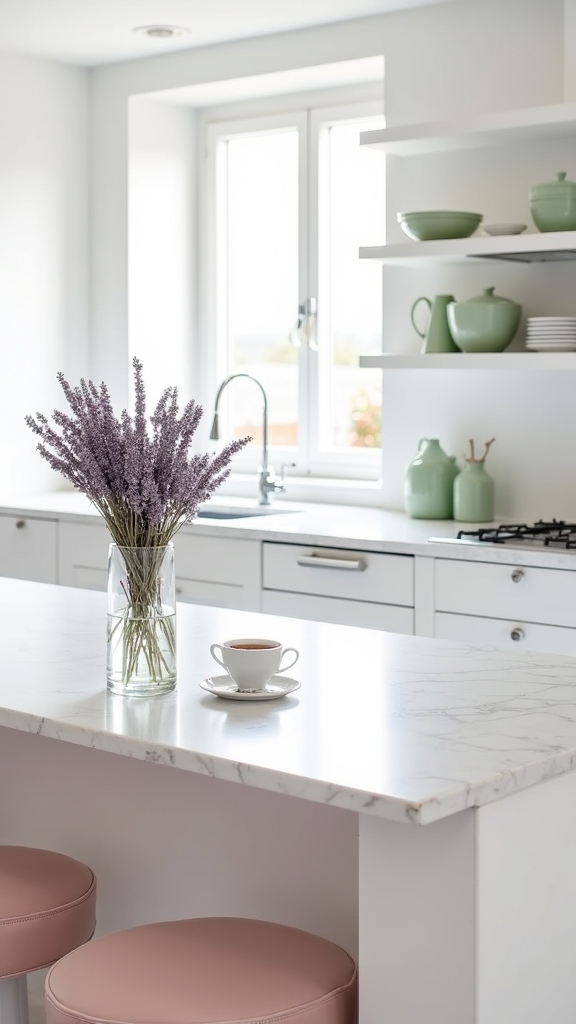
Although white kitchens epitomize clarity and spatial expansion, the integration of subtle pastel shades introduces nuanced chromatic variation that enhances visual interest without compromising luminosity.
Pastel accents—soft pinks, muted blues, or gentle greens—can be deployed in a manner that sustains an airy, modern, and elegant atmosphere. The strategic use of pastel elements enables spatial balance and visual zoning while preserving the kitchen’s contemporary integrity.
- Introduce pastel-toned dishware or textiles for a harmonious yet understated chromatic layer.
- Employ pastel backsplashes to establish focal points that maintain overall lightness and modern sophistication.
- Integrate pastel bar stools or pendant lighting to create elegant visual anchors within the space.
- Select pastel-accented artwork to infuse the kitchen with subtle color without overwhelming the minimalist white foundation.
Frequently Asked Questions
How to Make a White Kitchen Feel Cozy?
To make a white kitchen feel cozy, designers integrate textured materials, warm accents, and layered lighting to soften visual starkness. Incorporating personal touches strategically enhances spatial intimacy, aligning with current trends favoring tactile surfaces and inviting, human-centered environments.
What Is Replacing the White Kitchen?
Contemporary kitchen design trends are replacing the white kitchen with vibrant colorful accents, bold appliances, and textured materials. Spatial layouts now emphasize natural elements, integrating organic surfaces and mixed finishes to create dynamic, visually engaging, and personalized culinary environments.
How to Make a White Kitchen Not Boring?
To prevent monotony in a white kitchen, designers integrate textured materials for tactile interest, colorful accents as visual focal points, layered lighting for dimensionality, and unique backsplashes to introduce architectural character, reflecting contemporary spatial and trend-conscious approaches.
What Kitchen Design Never Goes Out of Style?
A kitchen design that never goes out of style seamlessly integrates timeless elegance, classic charm, minimalist aesthetics, and versatile functionality. This approach prioritizes enduring materials, balanced spatial organization, and subtle trend adaptation, ensuring perpetual relevance across evolving interior preferences.
Conclusion
White kitchens remain a perennial trend, offering spatial clarity and a versatile backdrop for both modern and classic aesthetics. Strategic layering of textures, materials, and accent elements enables homeowners to balance luminosity with visual interest. Incorporating high-contrast surfaces, heritage detailing, or subtle pastels enhances dimensionality while maintaining a cohesive palette. By utilizing these design principles, white kitchens transcend mere functionality, evolving into sophisticated, airy environments that respond to evolving lifestyle needs and contemporary design sensibilities.
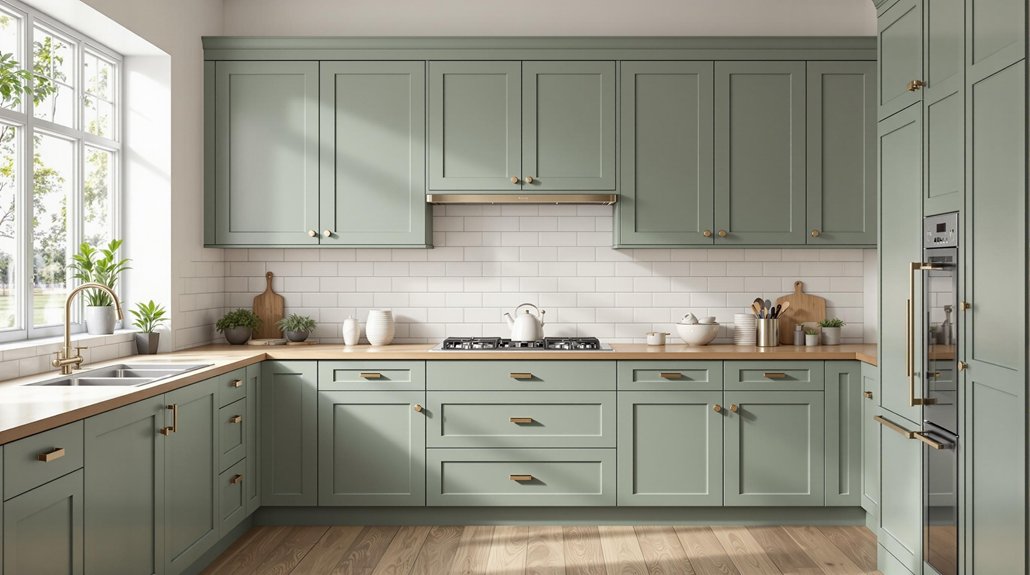
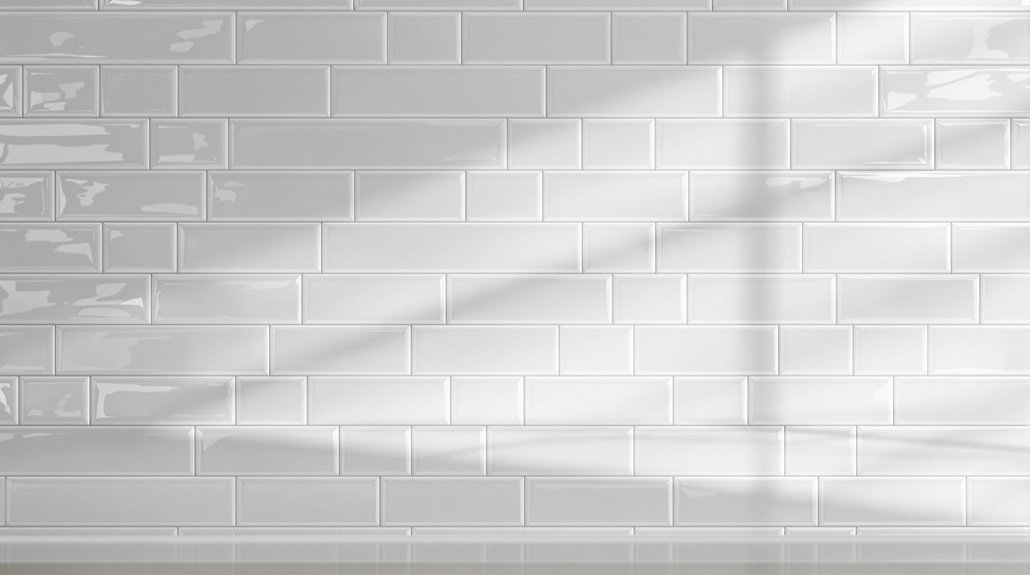

Leave a Reply